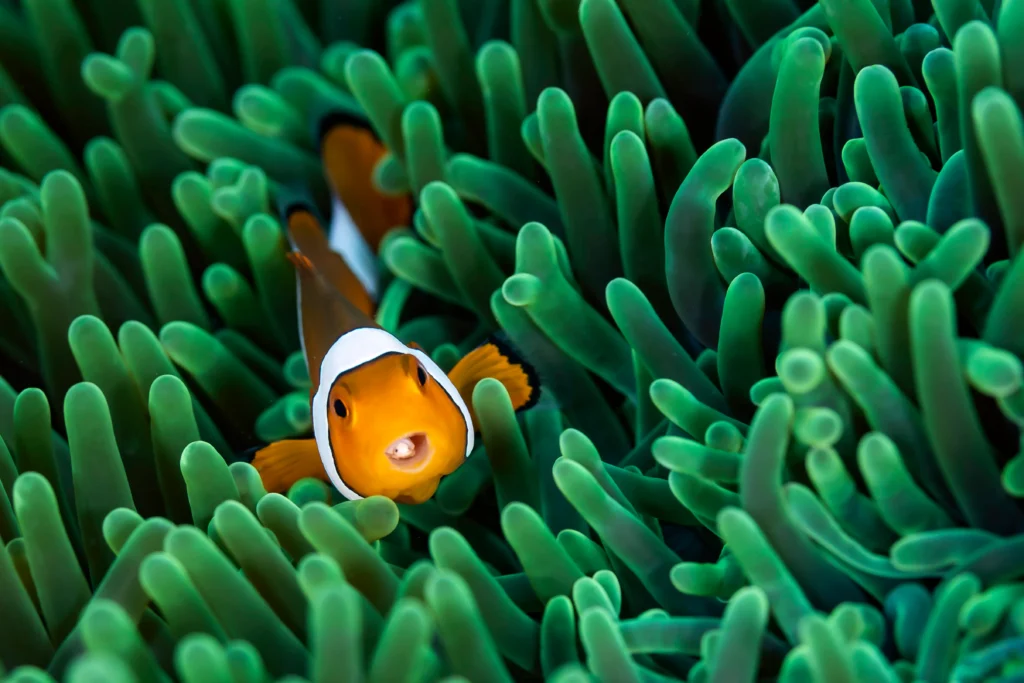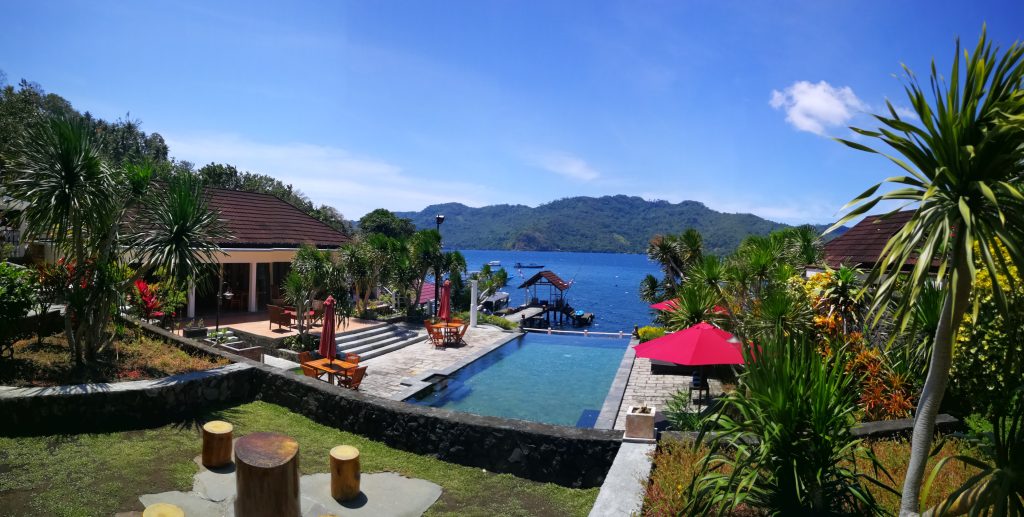The Lembeh Strait, a name whispered with reverence in the global diving community, isn’t your typical coral-draped tropical paradise. Instead, this unique channel in North Sulawesi, Indonesia, is where divers come to discover an entirely different kind of underwater magic.
Here, the adventure unfolds on dark volcanic sand, making Lembeh arguably the best muck diving site. This unique environment is a treasure trove for spotting rare and unusual critters, which in turn offers incredible opportunities for macro photography. Let’s see what makes Lembeh diving so special!
What Is Lembeh Strait Known for in the Diving Community?

Lembeh Strait is renowned worldwide and celebrated by divers as the “Muck Diving Capital of the World.” This unique style of diving focuses on exploring seabeds rich with volcanic sand, silt, and rubble. The Strait is acclaimed for its abundance of critters, making it a popular destination for macro diving.
As a result, Lembeh is also a top choice for underwater photography, especially for those looking to capture stunning close-up images. The dark volcanic substrate provides a beautiful contrast, making the bright colors of creatures like nudibranchs and frogfish exceptionally vivid in photographs.
What is the Best Time to Dive in Lembeh?
You can enjoy diving in Lembeh Strait at any time of year. While there’s a wet season (roughly November to June) and a dry season (April to October), rain usually falls in brief showers and seldom disrupts diving. Many divers find July through October to be an excellent period, as the water is cooler, around 25−26 °C (77−79 °F), often bringing Lembeh’s famous critters into shallower depths.
For macro photography, visibility, which can range from 5 to 20 meters, is generally good for focusing on your subjects up close. If you prefer the clearest water, October to December is often recommended. Ultimately, because most of Lembeh’s unique critters are present year-round and skilled local guides are experts at finding them, any season can be fantastic for your muck diving and photography adventure.
What Can You Do While Diving in Lembeh?
Lembeh Strait offers an extraordinary diving experience that highlights the strange, small, and often overlooked creatures of the underwater world. Every dive here is slow, intentional, and packed with discovery.
- Muck Diving and Macro Diving
Muck diving and macro diving are Lembeh’s signature style. You’ll explore silty bottoms, rubble, and scattered debris while searching for well-camouflaged critters like frogfish, pipefish, and nudibranchs. It is perfect for those who enjoy the thrill of spotting tiny, rare marine life up close. - Underwater Photography
Thanks to its high concentration of unique species and the contrasting volcanic sand, underwater photography in Lembeh is a dream for macro photography. The environment makes even the smallest subjects stand out, and many resorts, including Solitude Lembeh, offer facilities and guides tailored to photographers. - Night Diving
At night, Lembeh becomes even more surreal, prompting a lot of divers to do night diving. Creatures like Bobbit worms, cuttlefish, and crabs that hide during the day emerge in full force. Night dives here offer completely different encounters and a deeper sense of marine life behavior.
From shallow slopes to open ocean drifts, Lembeh’s dive offerings are rich, unusual, and unforgettable. They are ideal for divers who crave something beyond the ordinary.
What Marine Life Can You See While Diving in Lembeh?

Diving in Lembeh Strait offers an unforgettable look at some of the ocean’s most curious and rare marine life. The dark volcanic sand may seem barren at first, but look closer and you’ll find frogfish blending into the seafloor, the cute Nemo clownfish, and mimic octopuses imitating other sea creatures.
The diversity doesn’t stop there. Lembeh is famous for its colorful nudibranchs, which come in countless shapes and patterns, adding bursts of color to every dive. With each dive offering new surprises, Lembeh is a place where even the smallest creatures steal the show.
Which Dive Sites Should Not Be Missed in Lembeh?
Lembeh Strait boasts over 60 designated dive sites, each offering a unique window into its incredible critter diversity. While every dive promises discoveries, some sites have achieved legendary status:
- Nudi Falls and Nudi Retreat
These neighboring sites are famous for their vibrant variety. Nudi Falls offers a mix of wall, slope, and rubble terrain, often featuring nudibranchs, pygmy seahorses, frogfish, and the occasional Rhinopias. Nudi Retreat complements it with sandy patches and coral bommies, making both sites rich hunting grounds for macro enthusiasts. - Aer Prang (Air Prang)
Also known as a popular critter-hunting spot, this site is a classic black sand muck dive with scattered debris and algae patches. It’s an excellent place to spot octopuses, seahorses, scorpionfish, and a wide variety of crustaceans. The simplicity of the site makes it ideal for slow, focused critter spotting. - TK (Teluk Kembahu)
TK sites are shallow, gently sloping black sand bays known for calm waters and a concentration of rare critters. You’ll often find Flamboyant Cuttlefish, Wonderpus, frogfish, and Mimic Octopuses here. The conditions and visibility make it perfect for macro photography and long, unhurried dives.
The best sites often depend on recent sightings and conditions, so trust your experienced local dive guide!
How are the Diving Conditions in Lembeh?
Diving conditions in Lembeh Strait are generally calm and ideal for exploring its rich macro life. Water temperatures stay warm year-round, ranging from 25 to 29 °C, with the coolest months in July and August. Most dive sites are shallow, ranging from 5 to 25 meters, allowing for longer bottom times and providing great opportunities for macro photography. Visibility typically ranges from 5 to 20 meters, with the clearest water observed from October to December.
Currents are typically mild, thanks to the strait’s sheltered layout, making most sites easy to dive. A few spots near the main channel may have stronger flow, but dives are usually planned around slack tides. With calm conditions, shallow depths, and the availability of Nitrox, Lembeh is well-suited for slow, focused dives full of critter encounters.
Is Lembeh Suitable for Beginner Divers?

Yes, beginner divers are welcome in Lembeh Strait. Many of the dive sites are shallow, calm, and ideal for slow exploration, making them perfect for those just beginning their underwater journey. With guidance from experienced local dive professionals, even new divers can safely enjoy Lembeh’s rare and fascinating marine life.
Some of Lembeh’s more advanced activities, such as deeper muck sites, night dives, or blackwater photography, are even more rewarding with a bit of extra training and strong buoyancy control. Whether you’re newly certified or still building your skills, Solitude Lembeh offers a welcoming environment to grow as a diver and experience the magic of the Strait at your own pace.
How to Reach Lembeh for a Dive Trip?
Reaching Lembeh Strait is relatively straightforward, with Manado’s Sam Ratulangi International Airport (MDC) serving as the main gateway.
- Flights:
- International: Direct flights connect Manado (MDC) to Singapore (SIN) with airlines like Scoot. This is a popular route for international travelers.
- Domestic: Manado is well-connected to major Indonesian hubs like Jakarta (CGK), Bali/Denpasar (DPS), and Makassar (UPG) with multiple daily flights from airlines such as Garuda Indonesia and Lion Air.
- Airport Transfers:
- Most dive resorts in Lembeh will arrange airport transfers for their guests.
- The journey typically involves a car or van transfer from Manado airport to the port city of Bitung, which takes approximately 60 to 90 minutes.
- If your resort is on Lembeh Island itself, a short boat transfer of about 10 to 15 minutes from Bitung or a private mainland jetty will follow. Some mainland resorts are directly accessible by road.
Always confirm transfer arrangements with your chosen resort when booking.
Where Can You Stay While Diving in Lembeh?

Lembeh offers a range of accommodation options, primarily centered around dive resorts that cater to the unique needs of muck divers and underwater photographers.
For an exceptional stay, Solitude Lembeh Resort stands out as an ideal choice. Set in a peaceful private cove, it offers premium villas, expert dive guides, a dedicated camera room, and on-site photo pros to support your macro photography goals. With easy access to top dive sites and personalized service, Solitude Lembeh is perfect for divers seeking comfort, quality, and unforgettable underwater encounters.
Book Your Unforgettable Dive Journey to Lembeh Today!
The Lembeh Strait offers a dive experience focused on discovering rare and unusual marine life. Its dark volcanic sand seabeds make it the world’s best destination for muck diving, providing unmatched opportunities to find and photograph critters. This unique environment is why Lembeh is considered the global capital for macro photography.
At Solitude Lembeh Resort, we honor this intimate adventure. Nestled in a private cove, we provide the perfect sanctuary for your exploration: serene villas, world-class support for underwater photographers, and expert guides who know the secrets of the strait. When you are ready to discover the magic hidden in the muck, your story begins with us.
Book your next expedition in Lembeh here!